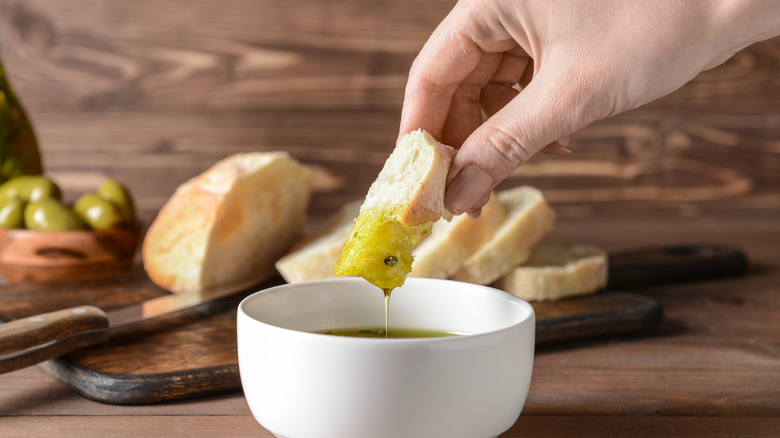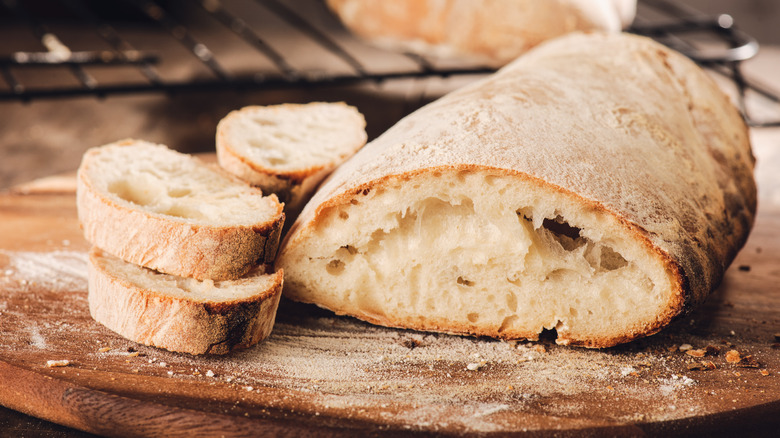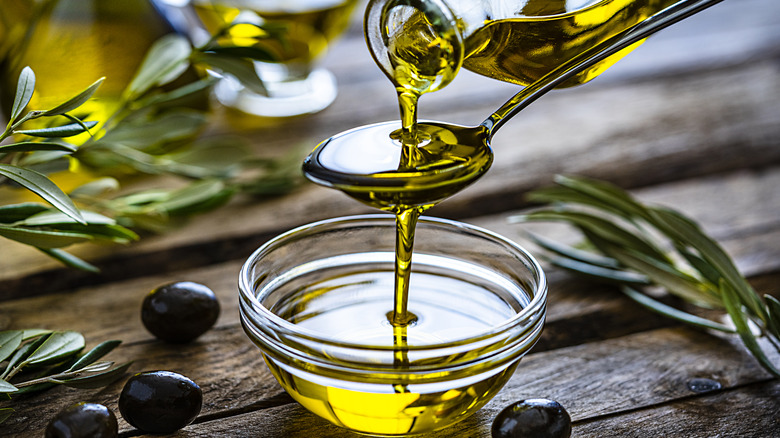The Best Kind Of Bread For Luxurious Olive Oil Dipping
Sliding fresh chunks of bread into high-quality olive oil is a sensory pleasure on so many levels, from taste to the aroma, visual appeal, and that crusty texture softened by glistening golden oil. It's one of gastronomy's simplest traditions, requiring only fingertips, unadorned chunks of bread, a bottle of good olive oil, and a few herbs if preferred. But somehow, that mere act of minimalist eating gets elevated to epicurean status in countless restaurants. For that to happen, there's got to be a secret ingredient, right? Many people, whether gourmands or earthy no-fuss eaters, say it's all about the bread.
The bread obviously must be fresh, not the pre-sliced loafs of bread stacked on supermarket shelves. But the type and style of bread are also crucial. It needs a crusty exterior that's hefty enough for holding in bare hands while dragging through the bowl of olive oil. And the interior must be soft, pliable, and absorbent to soak up all the flavorful oil. Ideally, you'll have a full fresh loaf to slice in thick portions just before indulging.
Olive oils have a connection to Mediterranean countries where olive trees grow in abundance, so it's natural to think of Italian bread for luxurious olive oil dipping. Given the 350-plus types of bread originating in Italy, it's no surprise some perfect types of dipping bread bear Italian names: ciabatta, focaccia, and Pugliese, a rustic bread from south Italy's Puglia region. Traditional crusty white loaves, French bread, sourdough, no-knead bread, or appropriately named olive bread are excellent choices as well.
Good crusty breads for dipping
Two popular and convenient kinds of bread for olive-oil dipping are commonly available in many countries: ciabatta (which is also perfect for deviled mushrooms on toast) and focaccia (delicious when stuffed with taleggio and pancetta). Extra crispy on the exterior, similar to a French loaf, ciabatta bread is sturdy enough for holding and is absorbent for a good dose of silky, aromatic olive oil. It's also easy to find in most supermarkets, either in the packaged bread department or the fresh bakery section. You'll recognize ciabatta by the relatively flat, oval shape that's often rounded on the edges, giving the appearance of a ballet or bedroom slipper –– thus it's affectionate nickname of slipper bread.
Focaccia bread, though not a hard type with crispy on the outside, is an excellent bread for mopping up olive oil. The pliable crispiness comes from a primary ingredient in this flatbread: olive oil. Its name comes from the old Roman phrase "panis focacius," translated as "hearth bread" due to original versions baked over coal embers in an open hearth. Focaccia typically comes seasoned on the upper crust with herbs such as rosemary, garlic, or basil soaked in olive oil, which nestles into the small pocketed indentions.
Another bread worth singling out for olive-oil dipping is the appropriately named olive bread. You're more likely to find it in regions such as California where olive groves thrive, or in specialty chain grocers such as Whole Foods or Trader Joe's. It can contain green olives, but more typically, black ones such as Kalamatas — which pair beautifully with farro.
The type of oil matters
After landing on a favorite bread for olive oil dipping, turn your attention to the oil itself. It features prominently in the experience, landing directly on your waiting taste buds, so the flavor is crucial. You want one that's minimally processed, retaining its grassy color and inherent earthy, fruity, peppery taste. That means extra virgin olive oil, if at all possible. To ensure you're getting a quality product, look for a use-by date; olives are notoriously finicky and will go bad quickly. A use-by date increases the odds of getting pure olive oil, not a blend. When it comes to olive oil, fresh is always best. It's comparatively pricey, but oils that have been heated and chemically treated lose flavor and appear bland on the palette.
Unless you're a devoted olive oil purist, you might want to try pre-flavored olive oils with citrus, chile, or pepper flavors. Or make your own herbal olive-oil dipping blends. Good blending options include dried Italian-style seasonings such as oregano, thyme, basil, and rosemary, mixed directly into the oil. Consider freshening up the flavor with finely diced or minced garlic and a sprinkle of grated parmesan, ideally from a fresh block instead of the powdery, canned variety.



